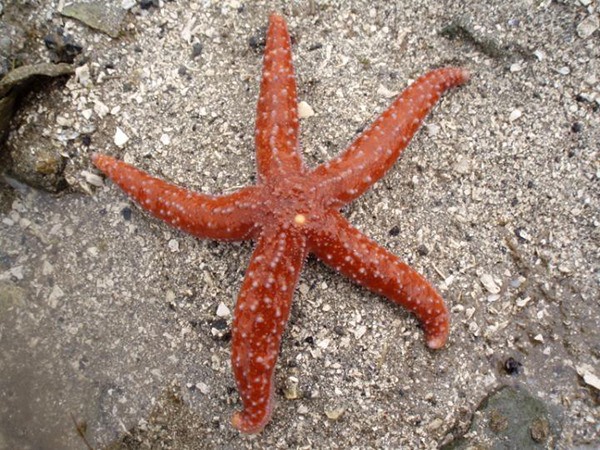Submitted by KWIAHT
The following five-year monitoring report at the Celebrate Indian Island event on Nov. 20. Below are the key findings, conclusions and recommendations.
Pacific Northwest sea surface temperatures were unusually high in summer 2014, and were still five degrees above the historical average as late as October. Warmer water brought more visitors to the islands, put more stress on inter-tidal animals and increased the spread of diseases of marine animals.
That’s a key message of the fifth annual report of the Indian Island Marine Health Observatory, released on Nov. 20 by the director of Kwiaht, Russel Barsh.
At the local level, several key indicators are down including eelgrass density, Bay Pipefish abundance in the eelgrass meadows, and the abundance of hard-shell clams such as “butter clams” in the beach. According to Barsh, silt loads in stormwater runoff from Eastsound streets may be a common factor driving these changes. The county’s detention pond has reduced annual silt discharges, Barsh says, and appears to have put a dent in the pesticide accumulations in clams, but the impacts of decades of untreated street runoff are probably cumulative and to some extent, irreversible.
Another impact factor is suggested by the fact that eelgrass declined faster in the shallower parts of Fishing Bay, which are exposed more often by low tides, and are used more by visitors. Recreational use may also be responsible for failure of the Indian Island oystercatcher pair (documented for the first time on special solar-powered cameras) to hatch any of their eggs last summer.
The report notes that some sea star species, such as “false ochre” stars, appear to have been declining at Indian Island since 2010 when monitoring began, although Sea Star Wasting Syndrome was not observed there until last winter. Nearly all SWS cases have been in ochre stars, which until last summer had remained conspicuously abundant at Indian Island while other seas stars decreased.
SWS affected barely 2 percent of Indian Island ochre stars from January to June but symptoms spiked in July. Ochre star numbers fell as the summer continued, not only because of disease, Barsh says, but also the heat, which in previous years drove sea stars into deeper water. By summer’s end, the incidence of SWS decreased, and many healthy small sea stars were observed around the island.
One positive trend has been an apparent increase in plainfin midshipmen, one of the most remarkable and fascinating fish that uses Indian Island to mate and brood eggs. Unlike Pipefish, which hunt and brood their young in the eelgrass meadows, midshipmen nest in rocky reefs and may be not be affected as much by losses of eelgrass.
Other good news is that terrestrial wildflower meadows are recovering gradually, helped by demarcation of the “driftwood trail” three years ago. Indian Island volunteers report that most visitors respect the closure of meadows for recovery, and this year they were rewarded with the most extensive vistas of blue camas, pink sea thrift and creamy rein orchids observed on Indian Island in over a decade.
Even after five years of data gathering, many puzzles and uncertainties remain. The report used a crab-abundance index based on four species that feed, hide and brood their eggs under rocks at the island, which were counted every two weeks in spring and summer. Index crabs increased steadily from 2010 to 2012 and then declined to 2010 levels.
It is too early to tell whether crab abundance at Indian Island is cyclical, and if so, why. One possibility is that infaunal crabs, like organisms as varied as rodents and oaks, survive only by periodically producing vastly more offspring than their predators can eat, Barsh says.
Indian Island’s diverse, colorful sea slugs vary unpredictably. A few species are seen consistently, but each winter, one or two new species drift into the bay and produce a swarm of offspring that dominate the community for another year or two. This makes it difficult to learn about the health of the bay from sea slug numbers, Barsh says. However, “sea slugs tend to be very picky eaters, like butterflies,” he adds, so that in principle, the variety of sea slug species visiting Indian Island over the years is an indicator of diversity and abundance of everything they eat from barnacles and bryozoans to sponges. Fourteen species of sea slugs have been recorded at Indian Island since 2010.
“The adventure begins here” is the motto of the Indian Island monitoring program, and the report makes it clear that the adventure of discovery and community involvement is just beginning.
At the same time, trends in the 2010-2014 data suggest that more can be done to keep Indian Island and Fishing Bay healthy and diverse, including more treatment of street runoff and containing foot traffic in inter-tidal habitats.
Special training for current and prospective volunteers at Indian Island and other marine monitoring sites around Orcas is available from January to June 2015. Contact the Indian Island team by email, kwiaht@gmail.com, on facebook or by visiting the website, http//www.kwiaht.org.



